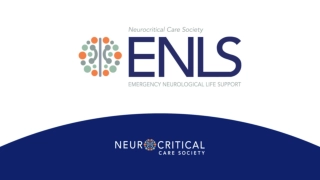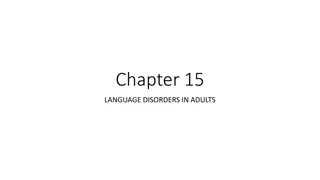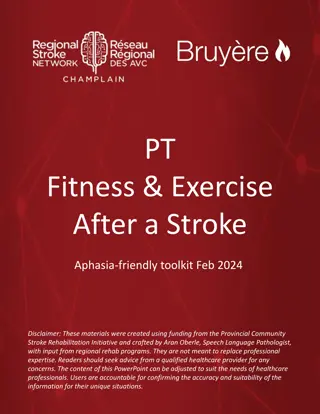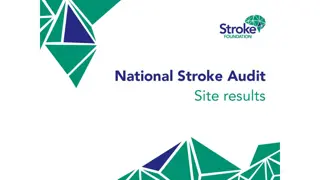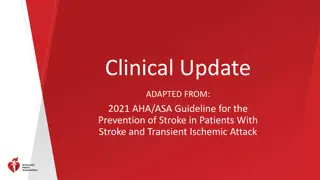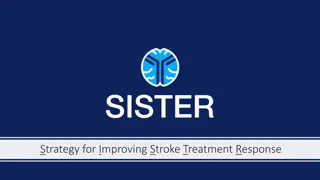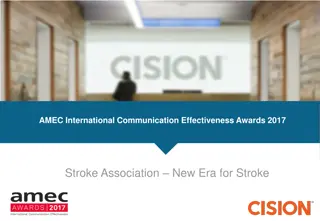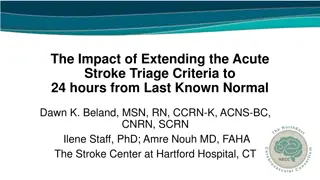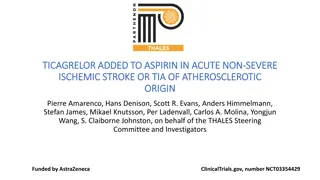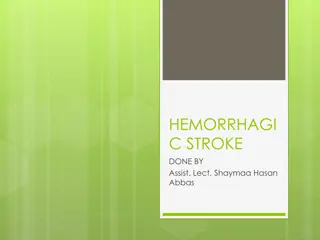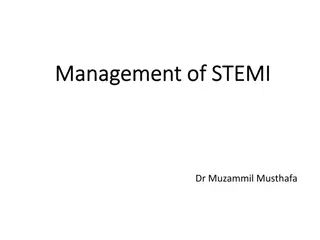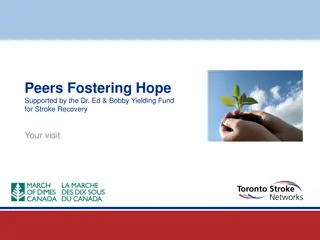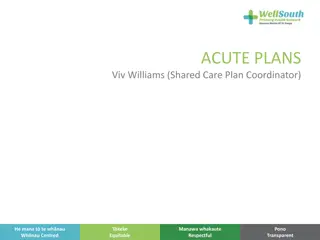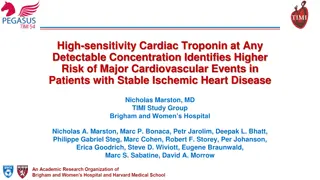Comprehensive Treatment Guidelines for Acute Ischemic Stroke
In the management of acute ischemic stroke, the primary goals are to reduce secondary brain damage, maintain adequate perfusion, and prevent recurrent strokes by managing risk factors. Treatment includes maintaining tissue oxygenation, correcting volume status and electrolytes, managing blood glucose levels, and using antihypertensive medications cautiously. Thrombolytic therapy with alteplase is a recommended treatment option. Fever should be treated, and heparin may be used for deep vein thrombosis prophylaxis. Careful monitoring and individualized care are crucial for optimizing outcomes in patients with acute ischemic stroke.
Download Presentation

Please find below an Image/Link to download the presentation.
The content on the website is provided AS IS for your information and personal use only. It may not be sold, licensed, or shared on other websites without obtaining consent from the author.If you encounter any issues during the download, it is possible that the publisher has removed the file from their server.
You are allowed to download the files provided on this website for personal or commercial use, subject to the condition that they are used lawfully. All files are the property of their respective owners.
The content on the website is provided AS IS for your information and personal use only. It may not be sold, licensed, or shared on other websites without obtaining consent from the author.
E N D
Presentation Transcript
ISCHEMIC STROKE Done by Assist.Lect. Shaymaa Hasan Abbas
DESIRED TREATMENT OUTCOMES The short-term goals of treatment for acute ischemic stroke include reducing secondary brain damage by re-establishing and maintaining adequate perfusion to marginally ischemic areas of the brain and to protect these areas from the effects of ischemia (i.e., neuroprotection). The long-term goals of treatment include prevention of a recurrent stroke through reduction and modification of risk factors and by use of appropriate treatments.
TREATMENT OF ACUTE ISCHEMIC STROKE 1. 2. 3. Tissue oxygenation should be maintained acutely Volume status and electrolytes should be corrected. If required, the blood glucose should be corrected, as both hyperglycemia and hypoglycemia may worsen brain ischemia.
TREATMENT OF ACUTE ISCHEMIC STROKE 4. If the patient is febrile, treat with acetaminophen, as fever is associated with brain ischemia and increased morbidity and mortality after stroke. 5. Intravenous (IV) and subcutaneous heparin will significantly decrease the risk of developing deep vein thrombosis (DVT) post- stroke .Heparin 5000 units subcutaneously every 12 hours should be given for DVT prophylaxis in patients who are not candidates for intravenous alteplase.
TREATMENT OF ACUTE ISCHEMIC STROKE 6- Blood pressure should be optimized; however, hypertension should generally not be treated initially in acute stroke patients, as this may cause decreased blood flow in ischemic areas, potentially increasing the infarction size. The cautious use of antihypertensive medications may be necessary in patients who are otherwise candidates for thrombolytic therapy, including those with severely elevated blood pressure (systolic BP greater than 220 mm Hg or diastolic BP greater than 120 mm Hg), and those with other medical disorders requiring immediate lowering of BP.
Thrombolytic Therapy 7- Thrombolytic Therapy Systemic Thrombolytic Therapy: The current American Stroke Association guidelines include alteplase as the only Food and Drug Administration (FDA) approved acute treatment for ischemic stroke and strongly encourage early diagnosis and treatment of appropriate patients.
Thrombolytic Therapy Withhold antiplatelet / antithrombotic medication until CT scan or MRI excludes haemorrhage. If the patient presents within 3 hours of onset of focal symptoms, thrombolysis may be appropriate. If patient presents > 3 hours, follow local protocol for stroke admissions. alteplase is effective in limiting the infarct size and protecting brain tissue from ischemia and cell death by restoring blood flow A dose of 0.9 mg/kg (maximum 90 mg) is recommended; the first 10% is given as an IV bolus and the remainder is infused over 1 hour.
Thrombolytic Therapy Antiplatelet agents, anticoagulants, and invasive procedures such as the insertion of a central line or the placement of a nasogastric tube should be avoided for 24 hours after the infusion of alteplase to prevent bleeding complications. Bladder catheterization should also be avoided for 30 minutes post-infusion.
Thrombolytic Therapy Streptokinase: Streptokinase is not indicated for use in acute ischemic stroke treatment. due to a high incidence of hemorrhage in the streptokinase-treated patients.
Thrombolytic Therapy Intra-arterial Thrombolytics Intra-arterial thrombolytics are typically avoided except at major stroke centers where there is more experience with this route of administration. Alteplase is the only product currently available; therefore, when intra-arterial thombolytics are given, alteplase must be used. Due to the limitations of intra-arterial thrombolysis, current guidelines recommend that treatment with IV alteplase in eligible patients not be delayed by waiting for intra-arterial thrombolytics
aspirin therapy is recommended in most patients with acute ischemic stroke within the first 24 to 48 hours after stroke onset and should be continued for at least 2 weeks. The administration of anticoagulants and antiplatelet agents should be delayed for 24 hours in those patients receiving alteplase.
PREVENTION OF ACUTE ISCHEMIC STROKE Primary Prevention Aspirin The use of aspirin in patients with no history of stroke or ischemic heart disease reduced the incidence of non-fatal myocardial infarction (MI) but not of stroke. A meta-analysis of eight trials found that the risk of stroke was slightly increased with aspirin use, especially hemorrhagic stroke. Statin Therapy Recent studies show that statin use may reduce the incidence of a first stroke in high-risk patients (e.g., hypertension, coronary heart disease, or diabetes) including patients with normal lipid levels.
Blood Pressure Management Lowering blood pressure in patients who are hypertensive has been shown to reduce the relative risk of stroke, both ischemic and hemorrhagic, by 35% to 45%.23 Also, the more blood pressure is lowered, the greater the reduction in stroke risk.
Secondary Prevention: Secondary prevention of stroke should be considered in all patients as soon as possible after their stroke. Nonpharmacologic Therapy Carotid Endarterectomy Carotid Angioplasty Carotid angioplasty with or without stenting is typically restricted to patients who are refractory to medical therapy and are not surgical candidates.
Pharmacologic Therapy Aspirin considered to be the first-line secondary prevention agent for ischemic stroke and decreases the risk of subsequent stroke by approximately 25% in both men and women with previous transient ischemic attacks or stroke. The FDA has approved doses of 50 to 325 mg for secondary ischemic stroke prevention.
Warfarin patients with atrial fibrillation usually start oral anticoagulants 10 to 14 days after the acute stroke, long-term anticoagulation with warfarin is recommended and is effective in both primary and secondary prevention of stroke. The goal International Normalized Ratio (INR) for this indication is 2 to 3.
Ticlopidine Ticlopidine is slightly more beneficial in stroke prevention than aspirin in both men and women. The usual recommended dosage is 250 mg orally twice daily. Ticlopidine is costly, and side effects include bone marrow suppression, rash, diarrhea, and an increased cholesterol level. Neutropenia is seen in approximately 2% of patients.
Clopidogrel Clopidogrel is slightly more effective than aspirin with a relativerisk reduction of 7.3% more than that provided by aspirin, and it may be considered as first-line therapy in patients with peripheral arterial disease. The usual dose is 75 mg orally taken on a daily basis. Clopidogrel has a significantly lower incidence of diarrhea and neutropenia than ticlopidine, and laboratory monitoring is typically not required.
Blood Pressure (BP) After the acute phase, all patients with a BP > 130 mmHg systolic or > 80 mmHg diastolic should be considered for a Long-acting angiotensin-converting enzyme inhibitor (ACEI) and a diuretic (such as bendroflumethiazide), if tolerated and not contraindicated. Add additional antihypertensives if BP remains above target level. Even normotensive patients (< 130 mmHg systolic or < 80 mmHg diastolic) may benefit from antihypertensive treatment, especially with ACEIs. Cholesterol: Unless contraindicated, treat all patients who have had an ischaemic stroke with a statin regardless of baseline cholesterol concentration. Recommended drug of choice is: Simvastatin oral 40 mg each night.


